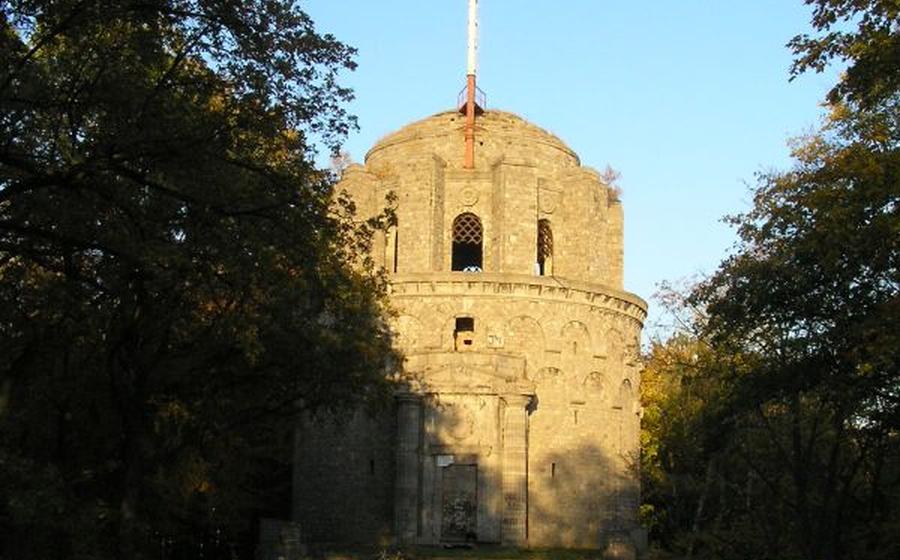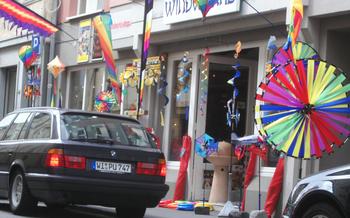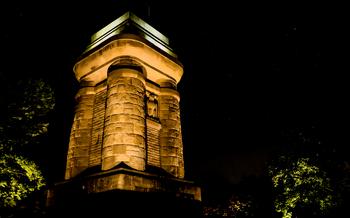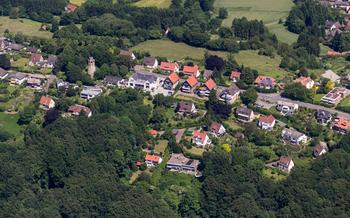
Bismarckturm (Bismarck Tower)
- A Monument to Iron and Steel
- A Panoramic Paradise
- A Glimpse into History
- The Journey to the Top
- A Symbol of Resilience
- A Place for Reflection
- A Touch of Nature
- A Hidden Gem
- A Symbol of Unity
- A Work of Art
- A Place of Learning
- A Source of Inspiration
- A Reminder of the Past
- Insider Tip
A Monument to Iron and Steel
In Wuppertal, nestled atop the Barmer Anlagen, stands the Bismarckturm, a proud testament to the city's rich history and architectural heritage. This colossal monument, rising 25 meters above the bustling streets, is a poignant reminder of the Bismarck cult that swept across Germany in the late 19th century. Erected in 1896 to honor the legacy of Chancellor Otto von Bismarck, the tower is an embodiment of the nation's gratitude and admiration for the Iron Chancellor, who is widely regarded as the unifier of Germany.
The Bismarckturm is an architectural masterpiece, a striking fusion of neo-Gothic and neo-Romanesque styles. Its sturdy construction, featuring granite and sandstone, reflects the strength and resilience of the man it commemorates. The tower's intricate carvings and decorative elements, such as the Bismarck coat of arms and various inscriptions, further enhance its aesthetic appeal.
The materials used in the tower's construction hold symbolic significance. Granite, known for its durability and strength, represents Bismarck's unwavering resolve and his enduring legacy. Sandstone, on the other hand, symbolizes the passage of time and the changing tides of history. Together, these materials create a harmonious blend of strength and transience, reflecting the complex and multifaceted nature of Bismarck's legacy.
A Panoramic Paradise
The Bismarckturm in Wuppertal offers visitors a breathtaking panorama of the city and its surroundings. From the tower's observation deck, one can enjoy sweeping views of the Wupper Valley, the Bergisches Land, and the distant skyline of Cologne. The tower's height and unobstructed views make it an ideal spot for photography enthusiasts, who can capture stunning images of the cityscape and the surrounding countryside.
On a clear day, visitors can see for miles in every direction. The Wupper River meanders through the valley below, surrounded by lush greenery and dotted with charming villages and towns. The Bergisches Land, with its rolling hills and forests, stretches out to the horizon. And in the distance, the iconic Cologne Cathedral can be seen, its spires reaching towards the sky.
To make the most of the views, it is recommended to visit the Bismarckturm on a clear day with good visibility. Visitors should also bring a camera or binoculars to capture the stunning scenery. For those interested in learning more about the history and significance of the tower, guided tours are available.
A Glimpse into History
The Bismarckturm in Wuppertal stands as a testament to the legacy of Otto von Bismarck, the Iron Chancellor who played a pivotal role in the unification of Germany. Bismarck's vision of a unified German nation under Prussian leadership was realized in 1871, and the Bismarck cult that emerged in the late 19th century celebrated his achievements. The construction of the Bismarckturm in Wuppertal in 1907 was part of this wave of Bismarck's memorialization and reflected the city's pride in its association with the Iron Chancellor.
The tower's design incorporates various elements that symbolize Bismarck's life and work. The use of iron and steel in its construction alludes to Bismarck's reputation as the "Iron Chancellor," while the tower's height of 35 meters represents Bismarck's 35 years as Chancellor of Germany. The reliefs and inscriptions on the tower further commemorate Bismarck's accomplishments, including the founding of the German Empire and the introduction of social reforms.
Over time, perceptions of Bismarck have evolved, and his legacy has been subject to scrutiny and debate. His authoritarian leadership style and realpolitik approach to politics have been criticized, while his contributions to German unification and modernization are still acknowledged. The Bismarckturm in Wuppertal thus serves as a reminder of a complex historical figure whose impact on Germany is still felt today.
The Journey to the Top
Reaching the Bismarckturm is a rewarding experience that can be tailored to suit different preferences and abilities. For those who enjoy an active adventure, several scenic hiking trails lead to the tower, offering panoramic views of the surrounding landscape.
Hiking Trails for Nature Enthusiasts:
-
The "Rundweg um den Toelleturm" trail is a popular choice, taking hikers through the picturesque Wupper Valley and past the historic Toelleturm.
-
The "Bismarckturmweg" trail offers a more challenging route with steeper climbs, leading directly to the tower.
-
Both trails provide opportunities to immerse oneself in the natural beauty of the Wuppertal region, with stunning views of the river, forests, and distant hills.
Accessibility Options for All:
-
For those with limited mobility or who prefer a more leisurely approach, there is a paved road leading directly to the tower.
-
Visitors can also take advantage of the Wuppertal Schwebebahn, a unique elevated railway system, to reach the nearby Zoo station and then walk to the tower.
Planning a Successful Visit:
-
To make the most of your visit, plan your trip around the weather forecast for optimal viewing conditions.
-
Check the opening hours of the tower, as they may vary depending on the season or special events.
-
Wear comfortable shoes and clothing suitable for walking or hiking, especially if you choose to explore the surrounding trails.
A Symbol of Resilience
Despite the ravages of World War II, the Bismarckturm in Wuppertal remarkably endured, standing as a testament to the resilience of both the tower and the city itself. While many buildings and landmarks were destroyed during the conflict, the tower remained relatively unscathed, a beacon of hope and strength amidst the devastation.
In the aftermath of the war, the tower underwent extensive restoration efforts, a symbol of the collective determination to rebuild and move forward. The restoration process was not merely about repairing physical damage but also about preserving the tower's historical and cultural significance.
Today, the Bismarckturm stands as a symbol of resilience, a reminder of the city's ability to overcome adversity and emerge stronger. It serves as a reminder that even in the darkest of times, there is always hope for renewal and reconstruction.
The tower's resilience is not only a testament to its physical strength but also to the indomitable spirit of the Wuppertal community. Through the years, the tower has become a symbol of unity and reconciliation, a place where people can come together to commemorate the past and celebrate the present.
As visitors stand atop the Bismarckturm, they are reminded of the strength and resilience of both the tower and the city it overlooks. The tower's endurance serves as an inspiration, encouraging us to face challenges with determination and to embrace the possibility of renewal and growth.
A Place for Reflection
The serene and contemplative atmosphere that surrounds the Bismarckturm makes it an ideal place for quiet contemplation and introspection. The tower's elevated position offers a sense of detachment from the hustle and bustle of everyday life, allowing visitors to immerse themselves in their thoughts and emotions. Whether seeking solace, inspiration, or simply a moment of peace, the Bismarckturm provides a sanctuary for personal reflection and meditation.
To create a meaningful and reflective experience, it is recommended to visit the tower during quieter hours, such as early morning or late afternoon. Find a secluded spot on the observation deck or in the surrounding park, where you can sit comfortably and let your thoughts flow freely. Take deep breaths of the fresh air and allow the tranquility of the environment to wash away any worries or distractions.
As you gaze out over the panoramic views, reflect on your own life journey, your aspirations, and the challenges you have faced. Consider the legacy of Otto von Bismarck and his impact on German history. What lessons can be learned from his life and his contributions? How can his example inspire you to make a positive impact on the world?
The Bismarckturm is a place where time seems to stand still, allowing you to connect with your inner self and find clarity and peace. Embrace this opportunity to pause, reflect, and recharge your spirit.
A Touch of Nature
Nestled within the verdant expanse of the Wuppertal Zoo, the Bismarckturm stands in harmony with the surrounding natural world. The zoo, a haven for wildlife, boasts a diverse array of animals, from majestic lions and playful monkeys to exotic birds and slithering reptiles. Visitors can embark on a safari-like adventure, observing the creatures in their natural habitats and gaining insights into their fascinating behaviors. The integration of nature and history at the Bismarckturm creates a unique and immersive experience, allowing visitors to appreciate the tower's architectural grandeur while immersing themselves in the wonders of the animal kingdom. Combining a visit to the tower with a zoo adventure offers a delightful opportunity to explore the intersection of history, nature, and wildlife.
A Hidden Gem
Despite its historical significance and architectural beauty, the Bismarckturm remains a hidden gem compared to other famous landmarks in Germany. This lesser-known status adds to its charm and exclusivity, offering visitors a unique and intimate experience. Without the overwhelming crowds of more popular tourist destinations, you can fully appreciate the tower's grandeur and soak in its serene atmosphere. Take advantage of this hidden gem and discover the Bismarckturm's captivating allure without the hustle and bustle of larger crowds.
Moreover, exploring hidden gems like the Bismarckturm allows you to go beyond the typical tourist trail and delve deeper into the local culture and history. Wuppertal is home to a variety of other hidden treasures, waiting to be discovered by curious travelers. Seek out these lesser-known places to gain a more authentic and immersive experience of the city and its rich heritage.
A Symbol of Unity
The Bismarckturm stands tall not only as a tribute to the Iron Chancellor but also as a symbol of unity and cohesion in Wuppertal. The tower has served as a gathering place for community events, bringing people together to celebrate their shared history and heritage. It has witnessed countless weddings, parties, and festivals, each adding to the tower's legacy as a symbol of unity.
One of the most poignant stories of unity associated with the Bismarckturm is the annual "Peace Light" ceremony. Every year, on the third Sunday of Advent, a group of Wuppertal residents gathers at the tower to receive a symbolic "Peace Light" from Bethlehem. This light is then distributed throughout the city, spreading a message of peace, hope, and unity to all corners of Wuppertal.
The Bismarckturm's role in fostering unity extends beyond community events. Its mere presence serves as a reminder of the shared history and values that bind the people of Wuppertal together. The tower stands as a symbol of their resilience, their determination, and their unwavering commitment to unity.
A Work of Art
The Bismarckturm in Wuppertal is not just a historical landmark but also a work of art that showcases the architectural and artistic prowess of its time. The tower's design incorporates various symbolic elements that reflect the significance of Otto von Bismarck and the German Empire. The tower's base, made of local sandstone, represents the strength and stability of the German nation. The upper section, constructed from iron and steel, symbolizes the country's growing industrial power during Bismarck's era.
The tower's exterior is adorned with intricate carvings and reliefs that depict scenes from German history and mythology. These include depictions of Bismarck himself, as well as allegorical representations of German virtues such as strength, courage, and unity. The tower's observation deck is crowned with a majestic eagle, a symbol of the German Empire.
The Bismarckturm's artistic value extends beyond its architectural features. The tower's location atop the Elberfeld Zoo adds to its unique charm and visual appeal. The juxtaposition of the tower's historical significance with the natural surroundings creates a captivating harmony that inspires awe and appreciation.
Whether you are an art enthusiast, a history buff, or simply someone who appreciates beauty, the Bismarckturm in Wuppertal is a must-visit destination. Its architectural grandeur, historical significance, and artistic value make it a true masterpiece that deserves to be admired and celebrated.
A Place of Learning
The Bismarckturm in Wuppertal offers a wealth of educational opportunities, serving as a valuable resource for history buffs, architecture enthusiasts, and anyone interested in German culture. Through guided tours, visitors can delve into the tower's rich historical significance, learning about the life and achievements of Chancellor Otto von Bismarck, the rise of the Bismarck cult, and the tower's role in commemorating German unification. The tower's unique architectural features and design elements provide a fascinating study in German architecture, showcasing the use of local materials and the influence of various architectural styles.
Moreover, the Bismarckturm presents an opportunity to explore local history and heritage. Visitors can learn about the development of Wuppertal from a small village to a thriving industrial city, and the impact of the Industrial Revolution on the region. The tower's resilience during World War II and its subsequent restoration serve as a testament to the strength and resilience of the German people. By incorporating the Bismarckturm into educational tours and programs, schools and organizations can provide students with a tangible connection to German history and culture, fostering a deeper understanding and appreciation for the country's past.
A Source of Inspiration
The Bismarckturm has served as a muse to numerous artists and writers, captivating their imaginations with its unique blend of history, nature, and architecture. The tower's imposing presence and panoramic vistas have inspired countless works of art, literature, and music.
One notable artist who found inspiration at the Bismarckturm was the German painter Carl Schuch. In his painting "Blick vom Bismarckturm auf Wuppertal" (View from the Bismarck Tower over Wuppertal), Schuch captured the tower's commanding position and the sprawling cityscape beyond. The painting's vibrant colors and bold brushstrokes convey the artist's awe and admiration for the tower's grandeur.
Another artist who drew inspiration from the Bismarckturm was the German writer Theodor Heuss. In his novel "Der Turm" (The Tower), Heuss used the tower as a symbol of strength and resilience, exploring the themes of war, loss, and renewal. The novel's protagonist, a young man who finds solace and inspiration in the tower, represents the resilience of the human spirit in the face of adversity.
The Bismarckturm continues to inspire contemporary artists and writers, who find in its timeless beauty and historical significance a rich source of creative expression. Whether through painting, writing, or music, the tower's ability to inspire and captivate remains undiminished.
A Reminder of the Past
The Bismarckturm stands as a solemn reminder of Germany's intricate and multifaceted past. Its very existence serves as a testament to the nation's triumphs and tribulations, its periods of prosperity and adversity. The tower's enduring presence invites visitors to embark on a journey through time, delving into the historical tapestry that has shaped modern-day Germany.
Within the tower's sturdy walls lie countless stories waiting to be unearthed. From its conception amidst the fervor of the Bismarck cult to its remarkable survival during the tumultuous years of World War II, the Bismarckturm has borne witness to pivotal moments in German history. Its scarred exterior, a testament to the ravages of war, speaks volumes about the resilience and determination of the German people.
Exploring the Bismarckturm is akin to embarking on a historical pilgrimage, where each step unveils a new chapter in the nation's narrative. Visitors can trace the evolution of Germany's political landscape, from the era of imperial grandeur to the complexities of the modern democratic state. The tower stands as a silent sentinel, inviting contemplation and reflection on the forces that have shaped Germany's destiny.
To fully appreciate the tower's historical significance, consider exploring other heritage sites in Wuppertal. The city boasts a wealth of historical landmarks, museums, and monuments, each offering a unique perspective on the region's rich past. From the historic old town to the Engels House, there's an abundance of opportunities to delve deeper into the city's captivating history.
Whether you're a history buff, a curious traveler, or simply someone with an appreciation for the past, the Bismarckturm and its surrounding historical sites offer an immersive and educational experience. Prepare to be transported back in time as you uncover the layers of history that have shaped this remarkable city and nation.
Insider Tip
-
For the most breathtaking views and a tranquil atmosphere, plan your visit to the Bismarckturm early in the morning or during the golden hours of sunset.
-
Discover hidden vantage points around the tower by exploring the surrounding park. These secluded spots offer unique perspectives and opportunities for capturing stunning photographs.
-
After your visit, indulge in a delicious meal or refreshing beverage at one of the charming cafes or restaurants located near the tower. These establishments provide a delightful culinary experience with a touch of local flavor.
-
Keep an eye out for special events and activities held at the Bismarckturm throughout the year. These events offer a chance to witness the tower in a new light and engage in unique experiences.







